Xiang Ao
Panoramic Interests: Stylistic-Content Aware Personalized Headline Generation
Jan 21, 2025Abstract:Personalized news headline generation aims to provide users with attention-grabbing headlines that are tailored to their preferences. Prevailing methods focus on user-oriented content preferences, but most of them overlook the fact that diverse stylistic preferences are integral to users' panoramic interests, leading to suboptimal personalization. In view of this, we propose a novel Stylistic-Content Aware Personalized Headline Generation (SCAPE) framework. SCAPE extracts both content and stylistic features from headlines with the aid of large language model (LLM) collaboration. It further adaptively integrates users' long- and short-term interests through a contrastive learning-based hierarchical fusion network. By incorporating the panoramic interests into the headline generator, SCAPE reflects users' stylistic-content preferences during the generation process. Extensive experiments on the real-world dataset PENS demonstrate the superiority of SCAPE over baselines.
Fact-Preserved Personalized News Headline Generation
Jan 21, 2025Abstract:Personalized news headline generation, aiming at generating user-specific headlines based on readers' preferences, burgeons a recent flourishing research direction. Existing studies generally inject a user interest embedding into an encoderdecoder headline generator to make the output personalized, while the factual consistency of headlines is inadequate to be verified. In this paper, we propose a framework Fact-Preserved Personalized News Headline Generation (short for FPG), to prompt a tradeoff between personalization and consistency. In FPG, the similarity between the candidate news to be exposed and the historical clicked news is used to give different levels of attention to key facts in the candidate news, and the similarity scores help to learn a fact-aware global user embedding. Besides, an additional training procedure based on contrastive learning is devised to further enhance the factual consistency of generated headlines. Extensive experiments conducted on a real-world benchmark PENS validate the superiority of FPG, especially on the tradeoff between personalization and factual consistency.
* Accepted by IEEE ICDM 2023, Short paper, 6 pages
Controlling Large Language Models Through Concept Activation Vectors
Jan 10, 2025Abstract:As large language models (LLMs) are widely deployed across various domains, the ability to control their generated outputs has become more critical. This control involves aligning LLMs outputs with human values and ethical principles or customizing LLMs on specific topics or styles for individual users. Existing controlled generation methods either require significant computational resources and extensive trial-and-error or provide coarse-grained control. In this paper, we propose Generation with Concept Activation Vector (GCAV), a lightweight model control framework that ensures accurate control without requiring resource-extensive fine-tuning. Specifically, GCAV first trains a concept activation vector for specified concepts to be controlled, such as toxicity. During inference, GCAV steers the concept vector in LLMs, for example, by removing the toxicity concept vector from the activation layers. Control experiments from different perspectives, including toxicity reduction, sentiment control, linguistic style, and topic control, demonstrate that our framework achieves state-of-the-art performance with granular control, allowing for fine-grained adjustments of both the steering layers and the steering magnitudes for individual samples.
Financial Risk Assessment via Long-term Payment Behavior Sequence Folding
Nov 22, 2024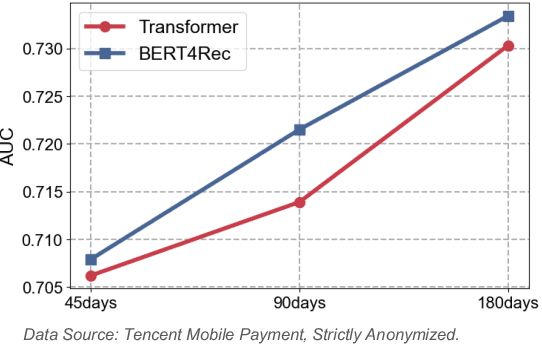
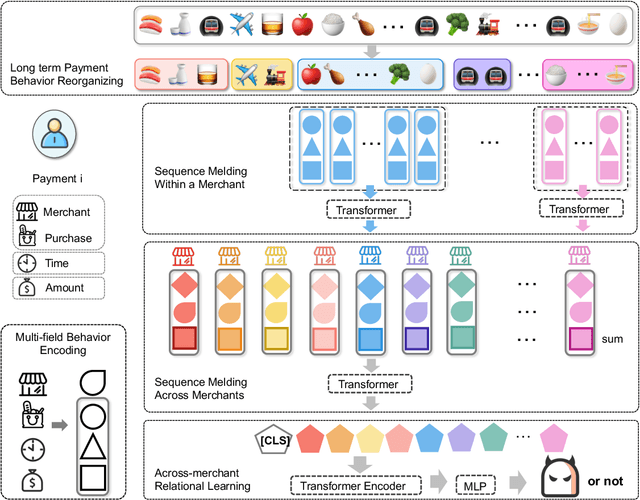
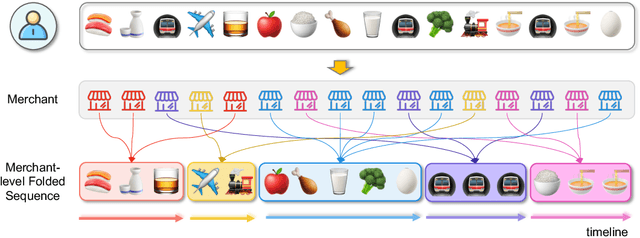
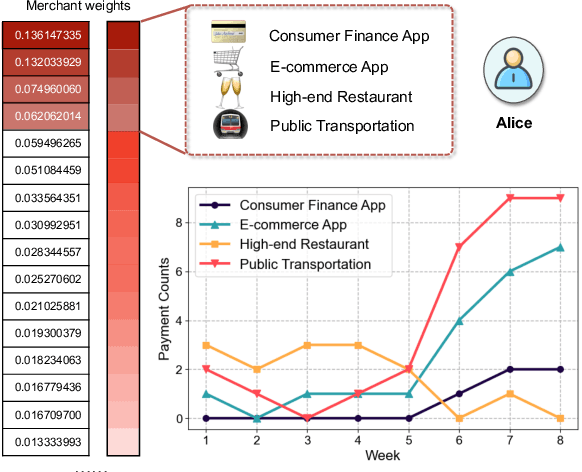
Abstract:Online inclusive financial services encounter significant financial risks due to their expansive user base and low default costs. By real-world practice, we reveal that utilizing longer-term user payment behaviors can enhance models' ability to forecast financial risks. However, learning long behavior sequences is non-trivial for deep sequential models. Additionally, the diverse fields of payment behaviors carry rich information, requiring thorough exploitation. These factors collectively complicate the task of long-term user behavior modeling. To tackle these challenges, we propose a Long-term Payment Behavior Sequence Folding method, referred to as LBSF. In LBSF, payment behavior sequences are folded based on merchants, using the merchant field as an intrinsic grouping criterion, which enables informative parallelism without reliance on external knowledge. Meanwhile, we maximize the utility of payment details through a multi-field behavior encoding mechanism. Subsequently, behavior aggregation at the merchant level followed by relational learning across merchants facilitates comprehensive user financial representation. We evaluate LBSF on the financial risk assessment task using a large-scale real-world dataset. The results demonstrate that folding long behavior sequences based on internal behavioral cues effectively models long-term patterns and changes, thereby generating more accurate user financial profiles for practical applications.
Adapting Vision-Language Models to Open Classes via Test-Time Prompt Tuning
Aug 29, 2024



Abstract:Adapting pre-trained models to open classes is a challenging problem in machine learning. Vision-language models fully explore the knowledge of text modality, demonstrating strong zero-shot recognition performance, which is naturally suited for various open-set problems. More recently, some research focuses on fine-tuning such models to downstream tasks. Prompt tuning methods achieved huge improvements by learning context vectors on few-shot data. However, through the evaluation under open-set adaptation setting with the test data including new classes, we find that there exists a dilemma that learned prompts have worse generalization abilities than hand-crafted prompts. In this paper, we consider combining the advantages of both and come up with a test-time prompt tuning approach, which leverages the maximum concept matching (MCM) scores as dynamic weights to generate an input-conditioned prompt for each image during test. Through extensive experiments on 11 different datasets, we show that our proposed method outperforms all comparison methods on average considering both base and new classes. The code is available at https://github.com/gaozhengqing/TTPT
AlphaForge: A Framework to Mine and Dynamically Combine Formulaic Alpha Factors
Jun 26, 2024



Abstract:The variability and low signal-to-noise ratio in financial data, combined with the necessity for interpretability, make the alpha factor mining workflow a crucial component of quantitative investment. Transitioning from early manual extraction to genetic programming, the most advanced approach in this domain currently employs reinforcement learning to mine a set of combination factors with fixed weights. However, the performance of resultant alpha factors exhibits inconsistency, and the inflexibility of fixed factor weights proves insufficient in adapting to the dynamic nature of financial markets. To address this issue, this paper proposes a two-stage formulaic alpha generating framework AlphaForge, for alpha factor mining and factor combination. This framework employs a generative-predictive neural network to generate factors, leveraging the robust spatial exploration capabilities inherent in deep learning while concurrently preserving diversity. The combination model within the framework incorporates the temporal performance of factors for selection and dynamically adjusts the weights assigned to each component alpha factor. Experiments conducted on real-world datasets demonstrate that our proposed model outperforms contemporary benchmarks in formulaic alpha factor mining. Furthermore, our model exhibits a notable enhancement in portfolio returns within the realm of quantitative investment.
LOGIN: A Large Language Model Consulted Graph Neural Network Training Framework
May 22, 2024



Abstract:Recent prevailing works on graph machine learning typically follow a similar methodology that involves designing advanced variants of graph neural networks (GNNs) to maintain the superior performance of GNNs on different graphs. In this paper, we aim to streamline the GNN design process and leverage the advantages of Large Language Models (LLMs) to improve the performance of GNNs on downstream tasks. We formulate a new paradigm, coined "LLMs-as-Consultants," which integrates LLMs with GNNs in an interactive manner. A framework named LOGIN (LLM Consulted GNN training) is instantiated, empowering the interactive utilization of LLMs within the GNN training process. First, we attentively craft concise prompts for spotted nodes, carrying comprehensive semantic and topological information, and serving as input to LLMs. Second, we refine GNNs by devising a complementary coping mechanism that utilizes the responses from LLMs, depending on their correctness. We empirically evaluate the effectiveness of LOGIN on node classification tasks across both homophilic and heterophilic graphs. The results illustrate that even basic GNN architectures, when employed within the proposed LLMs-as-Consultants paradigm, can achieve comparable performance to advanced GNNs with intricate designs. Our codes are available at https://github.com/QiaoYRan/LOGIN.
EFSA: Towards Event-Level Financial Sentiment Analysis
Apr 08, 2024Abstract:In this paper, we extend financial sentiment analysis~(FSA) to event-level since events usually serve as the subject of the sentiment in financial text. Though extracting events from the financial text may be conducive to accurate sentiment predictions, it has specialized challenges due to the lengthy and discontinuity of events in a financial text. To this end, we reconceptualize the event extraction as a classification task by designing a categorization comprising coarse-grained and fine-grained event categories. Under this setting, we formulate the \textbf{E}vent-Level \textbf{F}inancial \textbf{S}entiment \textbf{A}nalysis~(\textbf{EFSA} for short) task that outputs quintuples consisting of (company, industry, coarse-grained event, fine-grained event, sentiment) from financial text. A large-scale Chinese dataset containing $12,160$ news articles and $13,725$ quintuples is publicized as a brand new testbed for our task. A four-hop Chain-of-Thought LLM-based approach is devised for this task. Systematically investigations are conducted on our dataset, and the empirical results demonstrate the benchmarking scores of existing methods and our proposed method can reach the current state-of-the-art. Our dataset and framework implementation are available at https://anonymous.4open.science/r/EFSA-645E
Reliable Representations Make A Stronger Defender: Unsupervised Structure Refinement for Robust GNN
Jun 30, 2022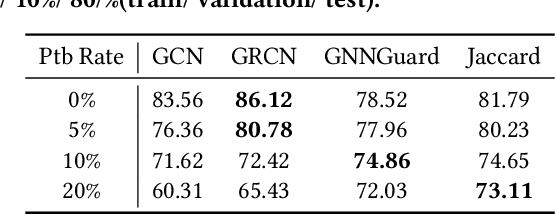
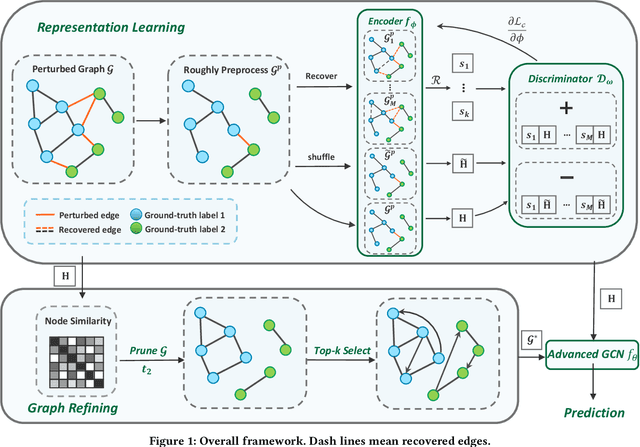
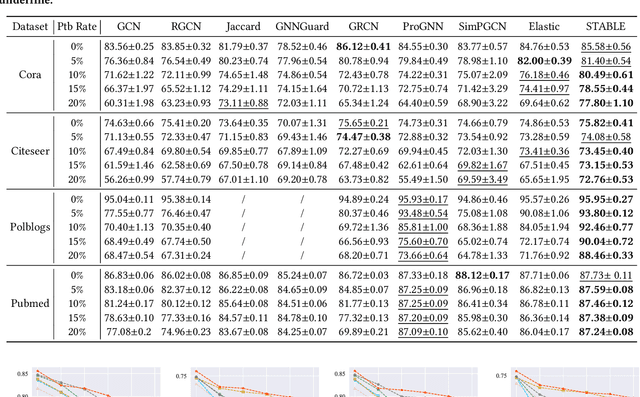
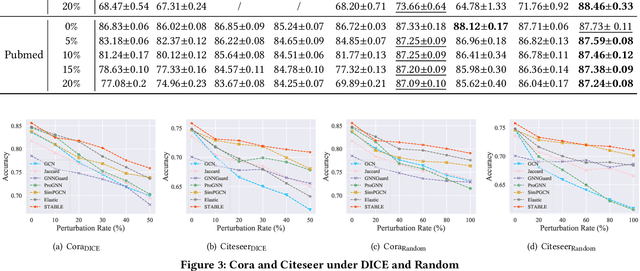
Abstract:Benefiting from the message passing mechanism, Graph Neural Networks (GNNs) have been successful on flourish tasks over graph data. However, recent studies have shown that attackers can catastrophically degrade the performance of GNNs by maliciously modifying the graph structure. A straightforward solution to remedy this issue is to model the edge weights by learning a metric function between pairwise representations of two end nodes, which attempts to assign low weights to adversarial edges. The existing methods use either raw features or representations learned by supervised GNNs to model the edge weights. However, both strategies are faced with some immediate problems: raw features cannot represent various properties of nodes (e.g., structure information), and representations learned by supervised GNN may suffer from the poor performance of the classifier on the poisoned graph. We need representations that carry both feature information and as mush correct structure information as possible and are insensitive to structural perturbations. To this end, we propose an unsupervised pipeline, named STABLE, to optimize the graph structure. Finally, we input the well-refined graph into a downstream classifier. For this part, we design an advanced GCN that significantly enhances the robustness of vanilla GCN without increasing the time complexity. Extensive experiments on four real-world graph benchmarks demonstrate that STABLE outperforms the state-of-the-art methods and successfully defends against various attacks.
Selective Fairness in Recommendation via Prompts
May 10, 2022



Abstract:Recommendation fairness has attracted great attention recently. In real-world systems, users usually have multiple sensitive attributes (e.g. age, gender, and occupation), and users may not want their recommendation results influenced by those attributes. Moreover, which of and when these user attributes should be considered in fairness-aware modeling should depend on users' specific demands. In this work, we define the selective fairness task, where users can flexibly choose which sensitive attributes should the recommendation model be bias-free. We propose a novel parameter-efficient prompt-based fairness-aware recommendation (PFRec) framework, which relies on attribute-specific prompt-based bias eliminators with adversarial training, enabling selective fairness with different attribute combinations on sequential recommendation. Both task-specific and user-specific prompts are considered. We conduct extensive evaluations to verify PFRec's superiority in selective fairness. The source codes are released in \url{https://github.com/wyqing20/PFRec}.
 Add to Chrome
Add to Chrome Add to Firefox
Add to Firefox Add to Edge
Add to Edge